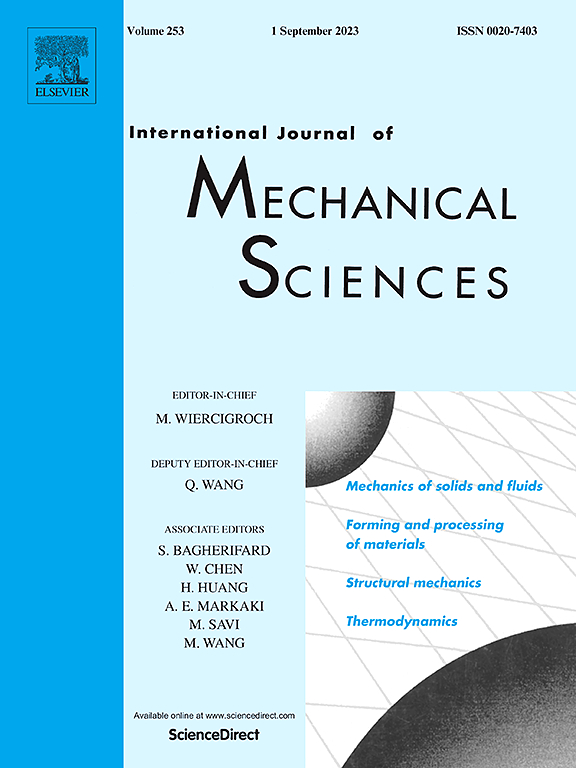纯Ni在低温下的应变硬化行为:实验和模型
IF 7.1
1区 工程技术
Q1 ENGINEERING, MECHANICAL
International Journal of Mechanical Sciences
Pub Date : 2025-04-20
DOI:10.1016/j.ijmecsci.2025.110293
引用次数: 0
摘要
随着极端环境应用需求的增加,金属在低温条件下的力学性能研究引起了人们的广泛关注。目前的研究考察了纯镍在77 K至298 K温度范围内的拉伸性能和应变硬化行为。结果表明,随着温度的降低,纯镍的屈服强度、抗拉强度和均匀伸长率显著提高,在77 K时效果显著。与298 K相比,77 K时的抗拉强度增加了约200 MPa。低温显著增强了应变硬化,主要是通过抑制动态恢复来实现的。增强的应变硬化和扩散剪切带的形成支持均匀变形,有助于提高低温下的均匀伸长率。利用实验数据和Kocks-Mecking模型,建立了一种改进的低温本构模型,用于描述温度降低对动态恢复的影响,并定量地将温度降低与应变硬化增强联系起来,并验证了其准确性。本研究阐明了纯镍在低温条件下强度和延展性同时增强的机制,为优化金属材料在低温条件下的性能及其在低温成型应用中的潜力提供了重要的理论指导。本文章由计算机程序翻译,如有差异,请以英文原文为准。

Strain hardening behavior of pure Ni at cryogenic temperatures: Experiments and modeling
Research on the mechanical properties of metals under cryogenic conditions has attracted considerable attention, driven by the increasing demand for applications in extreme environments. The current study examines the tensile properties, and strain-hardening behavior of pure nickel across a temperature range from 77 K to 298 K. Findings indicate a marked increase in yield strength, tensile strength, and uniform elongation of pure nickel as temperature decreases, with pronounced effects observed at 77 K. Tensile strength increases by roughly 200 MPa at 77 K compared to 298 K. The cryogenic temperature significantly enhances strain-hardening, primarily by inhibiting dynamic recovery. Enhanced strain hardening and the formation of diffuse shear bands, which support uniform deformation, contribute to the improvement in uniform elongation at lower temperatures. Utilizing experimental data and the Kocks-Mecking model, a modified constitutive model for cryogenic temperatures has been developed to describe the effect of temperature reduction on dynamic recovery and quantitatively linking temperature reduction to strain-hardening enhancement, with its accuracy verified. This research elucidates the mechanisms underlying the simultaneous enhancement of strength and ductility in pure nickel under cryogenic conditions, providing essential theoretical guidance for optimizing the properties of metallic materials in cryogenic conditions and their potential for cryo-forming applications.
求助全文
通过发布文献求助,成功后即可免费获取论文全文。
去求助
来源期刊

International Journal of Mechanical Sciences
工程技术-工程:机械
CiteScore
12.80
自引率
17.80%
发文量
769
审稿时长
19 days
期刊介绍:
The International Journal of Mechanical Sciences (IJMS) serves as a global platform for the publication and dissemination of original research that contributes to a deeper scientific understanding of the fundamental disciplines within mechanical, civil, and material engineering.
The primary focus of IJMS is to showcase innovative and ground-breaking work that utilizes analytical and computational modeling techniques, such as Finite Element Method (FEM), Boundary Element Method (BEM), and mesh-free methods, among others. These modeling methods are applied to diverse fields including rigid-body mechanics (e.g., dynamics, vibration, stability), structural mechanics, metal forming, advanced materials (e.g., metals, composites, cellular, smart) behavior and applications, impact mechanics, strain localization, and other nonlinear effects (e.g., large deflections, plasticity, fracture).
Additionally, IJMS covers the realms of fluid mechanics (both external and internal flows), tribology, thermodynamics, and materials processing. These subjects collectively form the core of the journal's content.
In summary, IJMS provides a prestigious platform for researchers to present their original contributions, shedding light on analytical and computational modeling methods in various areas of mechanical engineering, as well as exploring the behavior and application of advanced materials, fluid mechanics, thermodynamics, and materials processing.
 求助内容:
求助内容: 应助结果提醒方式:
应助结果提醒方式:


